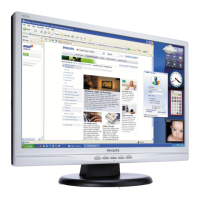
Do you have a question about the Philips 190CW7CS/00 and is the answer not in the manual?
| Screen Size | 19 inches |
|---|---|
| Display Type | LCD |
| Resolution | 1440 x 900 |
| Panel Type | TN |
| Aspect Ratio | 16:10 |
| Pixel Pitch | 0.285 mm |
| Brightness | 300 cd/m² |
| Contrast Ratio | 800:1 |
| Response Time | 5 ms |
| Input Connectors | VGA, DVI-D |
| Horizontal Refresh Rate | 30 - 83 kHz |
| Color Support | 16.7 million colors |
| Power Consumption Standby | 1 W |
| Viewing Angle | 160° (H) / 160° (V) |
| Controls & Adjustments | Brightness, Contrast |
| OSD Languages | English, French, German, Spanish, Italian, Russian, Chinese |
| Compliant Standards | TCO '03, Energy Star |
Details on handling precautions, laser safety, ESD protection, and general warnings for safe operation.
Detailed specifications of the LCD panel, including dimensions, pitch, color arrangement, and display surface.
Pin assignment details for the DVI-D input connector, listing each pin's signal designation.
Specifies operating and storage conditions for temperature, humidity, and air pressure.
Lists the items included in the accessory pack for monitor setup.
Step-by-step instructions for connecting the monitor to a computer and completing the setup.
Guides users on resolving issues like 'No Picture' and 'Screen says ATTENTION'.
Addresses problems related to incorrect display position, image vibration, and flickering.
Explains the OSD feature and how to use the control keys for adjustments.
Illustrates the hierarchical structure of the OSD menu for different regional models.
Procedures for locking and unlocking the On-Screen Display controls.
Steps to enter the aging mode and the factory mode for service adjustments.
Explains pixels, sub-pixels, and different types of pixel defects like bright and black dots.
Defines the acceptable levels and proximity tolerances for pixel defects for warranty claims.
Detailed steps on how to safely remove the monitor's base stand.
Instructions for removing the back cover and front bezel assembly.
Steps for aligning the monitor and adjusting white color balance.
Procedure to enter factory mode to access advanced color settings.
Answers common questions about video modes, drivers, and resolution.
Explains Auto function, cleaning, and color settings.
Details on analog and digital interface signals and timing specifications.
Lists factory preset modes, including horizontal and vertical frequencies and resolutions.
Overview of DDC, reprogramming, system requirements, and pin assignments.
Step-by-step guide for re-programming DDC data for analog and digital interfaces.
Details on the DDC data channel content, including vendor info and timing parameters.
Information on PC requirements and setting up the firmware update software.
Instructions for loading the firmware file and updating the monitor's CPU.
Provides a quick reference for common LCD panel failure descriptions and phenomena.
Schematic details for the scaler board related to VGA input signals.
Schematic details of the scaler board, including MCU and peripheral components.
Schematic details for the scaler board's LVDS output connections to the panel.
Schematic of the power supply section, detailing input and output circuitry.
Schematic of the power supply's inverter circuit for backlight control.
Schematic detailing the control board, key buttons, LEDs, and audio connections.
General description of the monitor, including its product profile and key features.
Detailed electrical specifications, including interface signals and scanning frequencies.
Specifications related to image size, brightness uniformity, and color adjustments.
Details on cosmetic aspects, materials, tooling, and physical properties.
Information on environmental susceptibility, transportation tests, and reliability.
Guidelines for handling, removing, and attaching SMDs, including ESD precautions.
Instructions for repairing lead-free products, including BGA rework.
Diagnostic flowcharts to identify and resolve power, image, and display problems.
Diagnostic flowcharts for 'No Display' errors and non-functional control keys.
Detailed instructions and requirements for performing Hi-Pot and Ground Continuity tests.
Lists necessary equipment and connection procedures for safety testing.
Comprehensive safety checks to perform after service, covering hazards like fire, shock, and X-radiation.
Procedures for leakage current checks and picture tube replacement safety.
